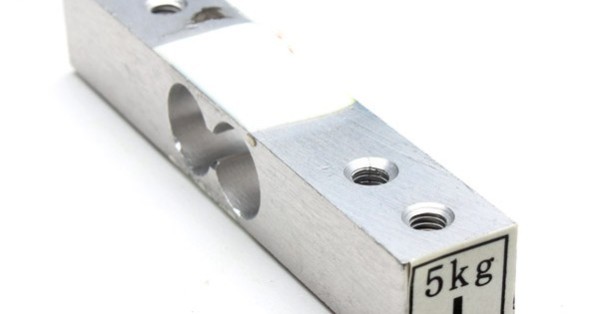








Load cell 5kg
This straight bar load cell (sometimes called a strain gauge) can translate up to 5kg of pressure (force) into an electrical signal. Each load cell is able to measure the electrical resistance that changes in response to, and proportional of, the strain (e.g. pressure or force) applied to the bar.
₹ 104 ₹149
149



| Made In : | India |
Add FAQ
A 5 kg load cell is a sensor used to measure weight or force with a maximum capacity of 5 kilograms. It's commonly used in applications where medium-range weights need to be measured, such as in small to medium-sized scales, load testing, or force measurement systems. Here's a detailed look at its components, functionality, and applications:
Components and Functionality
-
Strain Gauges:
- Strain Gauges: These are bonded to a metallic structure within the load cell. When a load is applied, the metal deforms slightly, causing the strain gauges to change resistance. This change is detected and measured.
- Wheatstone Bridge: Strain gauges are arranged in a Wheatstone bridge configuration to convert the strain into an electrical signal. This setup helps to increase measurement accuracy and minimize errors due to temperature changes or other factors.
-
Metallic Structure:
- Load Cell Body: Made from materials like aluminum or stainless steel, the structure is designed to flex under load. This deformation is measured by the strain gauges.
- Flexure: The part of the load cell that deforms under load, designed to optimize the load cell’s performance and accuracy.
-
Output Signal:
- Analog Output: Typically, the load cell provides a small analog voltage signal proportional to the applied load. This signal is often in the millivolt range and needs amplification.
- Digital Output: Some load cells include integrated ADCs and offer digital outputs that can be directly interfaced with microcontrollers or digital systems.
-
Amplifier:
- Signal Conditioning: The small output signal from the load cell is amplified and conditioned to make it suitable for processing. This is often done using a dedicated load cell amplifier or signal conditioning circuit.
Specifications
- Capacity: 5 kg (kilograms) or approximately 50 N (Newtons).
- Accuracy: Usually specified as a percentage of full scale, such as ±0.1% FS (Full Scale).
- Output Sensitivity: Typically expressed in mV/V, which indicates how many millivolts are output per volt of excitation voltage applied.
Applications
- Weighing Scales: Used in digital scales for weighing items up to 5 kg.
- Force Measurement: In testing systems for measuring forces applied to materials or components.
- Robotics: For measuring force or load in robotic applications and load monitoring.
- Load Testing: To determine the load-bearing capacity of structures or components in various industries.
Connecting a Load Cell
-
Wiring:
- Excitation Wires: Provide power to the load cell (commonly labeled E+ and E-).
- Signal Wires: Output the measurement signal (often labeled S+ and S-).
- Shielding: Proper grounding and shielding are crucial to reduce electrical noise and improve accuracy.
-
Amplifier/Controller:
- Amplifier: Connect the load cell to an amplifier or signal conditioner to boost the small signal to a usable level.
- Analog-to-Digital Converter (ADC): If using a digital output, an ADC may be integrated into the amplifier or used separately to convert the analog signal into a digital format.
-
Calibration:
- Calibration: Essential for accuracy, involving applying known weights to the load cell and adjusting the system to ensure the output matches the actual load.
Example Setup
- Power Supply: Provide the load cell with the appropriate excitation voltage (commonly 5V or 10V).
- Signal Conditioning: Use a load cell amplifier like the HX711 or a similar module to amplify and convert the signal.
- Data Processing: Interface the amplified signal with a microcontroller or digital display for reading and processing.
Practical Tips
- Mounting: Ensure proper alignment and secure mounting to avoid measurement errors due to mechanical misalignment.
- Environmental Factors: Consider temperature and humidity, as these can affect the load cell's accuracy. Many load cells are designed to operate within specific environmental conditions.
If you have a specific project or need further assistance with integrating a 5 kg load cell into your system, let me know!
0 Reviews For this Product









2.jpeg&width=225&quality=80)
2.jpeg&width=225&quality=80)
.jpeg&width=225&quality=80)

